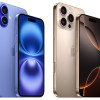Review: LG L90 for T-Mobile
The L90 runs Android 4.4.2 (KitKat) with LG's user experience along for the ride. it functions almost identically to what's on other recent LG devices.
The lock screen is adjustable and lets users view a clock, or clock plus some shortcuts. The L90 supports passwords of all types, but the camera can be opened without entering a password. The home screens number five out of the box, but can be added/deleted at will.
LG offers one of the more adjustable app menus in the industry. App menu icons can be set to large or small, sorted alphabetically or via install date, and can be hidden or deleted easily. The notification shade works pretty much the same as it does on other Android devices, but in the L90's case it adds LG's QSlide apps to the radio toggles and notifications. The shortcuts and other controls can be adjusted to suit your tastes. The L90 also supports LG's Easy Mode, which presents a simplified user interface for novice smartphone users.
The settings menu can be viewed in either a single list (my preferred) or in four separate tabs (default). I find the default, tabbed view confusing and slower than the single list. At least LG lets you pick. The L90 includes a handful of fonts, each of which can be set to a handful of different sizes. It has several themes, myriad wallpapers, tons of tones, and so on.
I was not blown away by the L90's performance. It has the same 1.2 GHz quad-core Qualcomm Snapdragon 400 processor found in the Lucid 3, but for some reason the L90 is a bit sluggish from time-to-time. Further, apps often took a bit longer than they should have to load, and the UI sometimes stuttered when transitioning between screens and apps. This is the first device with a Snapdragon 400 to show me that sort of trouble.
Calls and Contacts
The phone and contact apps are carried over directly from earlier LG Android handsets and don't differ in any meaningful way.
The phone app provides tabbed access to call history, contacts, favorites, and groups along the top, in addition to a standard dialpad. In-call options include the ability to add a line, send to Bluetooth, hold, reject with message, or mute. You can also open the notepad and messaging apps. The L90 lacks a noise cancellation option. LG's contacts application lets users choose which account(s) it syncs with and/or displays, how contacts are arranged, or easily lump them together into groups. The L90 has several contact widgets for the home screen.
Both the phone and contact apps are available as QSlide mini-apps. There's a button in the phone dialer and a corresponding one on the contact screen that minimizes the app, but leaves it open and running on top of other apps. This means you can always have the phone controls or your contacts front and center while performing other tasks. QSlide apps take some getting used to, but they are helpful once you learn what they can do.
Messaging
The L90 offers only the most basic messaging tools expected from a modern smartphone. There is a generic messaging app for traditional SMS/MMS, as well as Google Hangouts, which incorporates live video chats and IM. The Google-made Gmail app is on board, as is the generic Google email app. Google+ is the only social network preinstalled. You'll have to download Facebook/Twitter and any other third-party messaging apps on your own.































 T-Mobile and MetroPCS Score LG's L Series III Phones
T-Mobile and MetroPCS Score LG's L Series III Phones
 Samsung Refreshes Galaxy S Series with S Pen, New Cameras
Samsung Refreshes Galaxy S Series with S Pen, New Cameras
 iPhone 14 Plus Offers a Big Screen For Less
iPhone 14 Plus Offers a Big Screen For Less
 Snapdragon 8 Gen 2 Redefines AI in Flagship Phones
Snapdragon 8 Gen 2 Redefines AI in Flagship Phones
 iPhone 16 Brings More Features to All Price Points, Including New Camera Control
iPhone 16 Brings More Features to All Price Points, Including New Camera Control
 LG Optimus L90
LG Optimus L90




